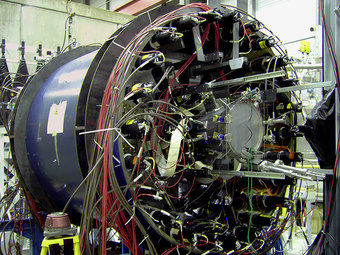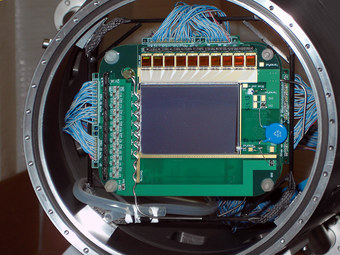Exakte Messung der Polarisierbarkeit von Pionen stützt Standardmodell
2015-02-10 – Nachrichten aus dem Physik-Department

Die gesamte sichtbare Materie im Universum besteht aus winzigen Elementarteilchen, aus Quarks und Elektronen. Die Bausteine der Atomkerne wiederum, die Protonen und Neutronen, sind aus drei Quarks aufgebaut. Ein Gold-Atomkern etwa besteht aus 79 Protonen und 118 Neutronen. Sie tauschen so genannte Pionen aus, wodurch der Atomkern zusammenhält.
Pionen bestehen aus einem Quark und einem Antiquark, welche wiederum von der starken Wechselwirkung fest aneinander gebunden werden. Das Ausmaß, in dem diese beiden Bestandteile voneinander entfernt werden können, ist daher ein direktes Maß für die Stärke der Bindungskraft zwischen den Quarks und damit für die starke Wechselwirkung.
Extrem starkes elektrisches Feld
Um die Verformbarkeit der geladenen Pionen – Physiker sprechen auch von ihrer Polarisierbarkeit – zu messen, schossen die Wissenschaftler des COMPASS-Experiments am CERN einen Pionen-Strahl auf eine Nickelscheibe. Die Pionen näherten sich den Nickel-Atomkernen dabei auf Distanzen von im Mittel nur zwei Kernradien und erfuhren dabei das sehr starke elektrische Feld des Nickelkerns.
Dieses elektrische Feld verursacht eine Polarisierung der Pionen und ändert ihre Flugbahn unter Aussendung von Photonen, also Lichtteilchen. Aus der Messung der Photonen und der Ablenkungen der Pionen für eine große Anzahl von 63.000 Pionen konnten die Wissenschaftler die Polarisierbarkeit der Teilchen bestimmen.
Das Ergebnis zeigt, dass die Pionen nur zu weit weniger als ein Tausendstel ihres Volumens deformierbar sind. „Das Experiment ist – trotz der hohen Teilchenenergien am CERN – eine große Herausforderung”, sagt Professor Stephan Paul vom Physik-Lehrstuhl E18 an der TU München und Koordinator der Exzellenzclusters Universe. „Der Effekt der Pion-Polarisierbarkeit ist winzig. Dies macht die Stärke der inneren Kräfte besonders deutlich.”
Ergebnisse revidieren frühere Messungen

Erste in den 1980er Jahren durchgeführte Messungen hatten Ergebnisse geliefert, die im Widerspruch zu den theoretischen Vorhersagen standen und die Physiker vor große Rätsel gestellt. „Die Theorie der starken Wechselwirkung ist einer der Grundpfeiler unseres Verständnisses der Natur auf der Ebene der Elementarteilchen”, sagt PD Dr. Jan Friedrich, Wissenschaftler am Physik-Lehrstuhl E18 der TUM und Mitglied des Exzellenzclusters Universe, der die Datenanalyse der COMPASS-Kollaboration leitete. „Daher ist die gute Übereinstimmung dieses Ergebnisses mit der Theorie von großer Bedeutung.”
Das COMPASS-Experiment wird seit 2002 am Super Proton Synchrotron (SPS) betrieben, dem zweitgrößten Beschleunigerring am CERN. Zur Kollaboration gehören rund 220 Physiker aus 13 Ländern. In Deutschland sind die Unis in Bielefeld, Bochum, Bonn, Erlangen-Nürnberg, Freiburg, Mainz und München beteiligt sowie die Technische Universität München, bei der die Verantwortung für die Datenanalyse lag.
Die Forschungsarbeiten wurden in Deutschland unterstützt vom Bundesministerium für Bildung und Forschung (BMBF), der EU-Forschungsförderungslinie FP7 und der Deutschen Forschungsgemeinschaft (Exzellenzcluster Origin and Structure of the Universe).
- Redaktion
- Dr. Andreas Battenberg, Dr. Johannes Wiedersich
Veröffentlichung
Kontakt
| Prof. Dr. Stephan Paul | PD Dr. Jan Friedrich |
|---|---|
| E-Mail: Stephan.paul@tum.de | E-Mail: jan@tum.de |
| Tel.: +49 89 289 12571 | Tel.: +49 89 289 12586 |